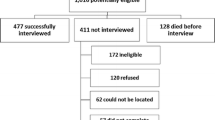Abstract
Lyme disease (LD), a vector-borne disease, causes illness for many individuals in the United States. All of the conditions for the promulgation of LD are present in one Southern state in the United States; yet this state reports lower numbers of LD than adjacent states. The purpose of this study was to determine associations between this Southern state’s primary care providers’ knowledge and attitudes regarding the diagnosis and reporting of LD. A quantitative, cross-sectional study was conducted via a mailed questionnaire by the Arkansas Department of Health to 2,693 primary care providers. Respondents were 660 primary care providers from all regions of this state. Secondary data were analyzed using descriptive, Chi square, and logistic regression techniques. Analysis results included the following: a correct response rate of 59.1 % for symptom recognition, of 46.2 % for knowledge of recommended testing processes, and of 78.9 % for knowing LD is a reportable disease. These results compared to the expected norm were significant in every area with p values of .000. Specialty, region, and years of practice were found to be confounding influences in a number of assessment areas.
Similar content being viewed by others
References
Griffin, D. (2007). Lyme disease. In K. Nelson & C. Williams (Eds.), Infectious disease epidemiology: Theory and practice (2nd ed., pp. 1063–1086). Sudbury, MA: Jones and Bartlett Publishers.
World Health Organization. (2013). Lyme borreliosis (lyme disease). Retrieved from http://www.who.int/ith/diseases/lyme/en/index.html.
Centers for Disease Control and Prevention. (2012). Confirmed lyme disease cases by age and sex—United States, 2001–2010. Retrieved from http://www.cdc.gov/lyme/stats/chartstables/incidencebyagesex.html.
Centers for Disease Control and Prevention. (2012). Lyme disease: Reported lyme disease cases by state, 2000–2010. Retrieved from http://www.cdc.gov/lyme/stats/chartstables/reportedcases_statelocality.html.
Centers for Disease Control and Prevention. (2007). Lyme disease—United States, 2003–2005. Morbidity and Mortality Weekly Report, 56(23), 573–576.
Centers for Disease Control and Prevention. (2012). Lyme disease: Reported cases of lyme disease by year, United States, 2002–2011. Retrieved from http://www.cdc.gov/lyme/stats/chartstables/casesbyyear.html.
Boltri, J., Hash, R., & Vogel, R. (2002). Patterns of Lyme disease diagnosis and treatment by family physicians in a southeastern state. Journal of Community Health, 27(6), 395–402.
Magri, J., Johnson, M., Herring, T., & Greenblatt, J. (2002). Lyme disease knowledge, beliefs, and practices of New Hampshire primary care physicians. Journal of American Board of Family Medicine, 15(4), 277–284.
Henry, B., Crabtree, A., Roth, D., Blackman, D., & Morshed, M. (2012). Lyme disease: Knowledge, beliefs, and practices of physicians in a low-endemic area. Canadian Family Physician, 58, e289–e295.
Centers for Disease Control and Prevention. (2012). 2012 case definitions: Nationally notifiable conditions infectious and non-infectious case. Retrieved from http://wwwn.cdc.gov/nndss/document/2012_Case%20Definitions.pdf.
Bhate, C., & Schwartz, R. (2011). Lyme disease: Part II. Management and prevention. Journal of American Academy of Dermatology, 64(4), 639–653. doi:10.1016/j.jaad.2010.03.047.
Stanek, G., Wormser, G., Gray, J., & Strle, F. (2012). Lyme borreliosis. The Lancet, 379, 461–473. doi:10.1016/50140-6736(11)60103-7.
Aucott, J., Seifter, A., & Rebman, A. (2012). Probable late lyme disease: A variant manifestation of untreated Borrelia burgdorferi infection. BMC Infectious Diseases, 12(173), 1–10.
Feder, H., Johnson, B., O’Connell, S., Shapiro, E., Steere, A., & Wormser, G. (2007). A critical appraisal of “chronic lyme disease”. The New England Journal of Medicine, 357, 1422–1430.
Nadelman, R., & Wormser, G. (2007). Reinfection in patients with Lyme disease. Clinical Infectious Diseases, 45, 1032–1038. doi:10.1086/521256.
Patil, N., Baiola, R., Saccente, M., Vyas, K., & Bradsher, R. (2010). A clinical review of Lyme disease in Arkansas. The Journal of the Arkansas Medical Society, 106(8), 186–188.
Pepin, K., Eisen, R., Mead, P., Piesman, J., Fish, D., Hoen, A., et al. (2012). Geographic variation in the relationship between human lyme disease incidence and density of infected host-seeking Ixodes scapularis nymphs in the Eastern United States. The American Journal of Tropical Medicine and Hygiene, 86(6), 1062–1071. doi:10.4269/ajtmh/2012.11-0630.
Eisen, R., Piesman, J., Zielinski-Gutierrez, E., & Eisen, L. (2012). What do we need to know about disease ecology to prevent Lyme disease in the northeastern United States? Journal of Medical Entomology, 49(1), 11–22.
LoGiudice, K., Ostfeld, R., Schmidt, K. A., & Keesing, F. (2003). The ecology of infectious disease: Effects of host diversity and community composition on Lyme disease risk. Proceedings of the National Academy of Sciences, 100(2), 567–571. doi:10.1073/pnas.023733100.
Brownstein, J., Holford, T., & Fish, D. (2005). Effect of climate change on lyme disease risk in North America. EcoHealth, 1(2), 38–46. doi:10.1007/s10393-004-0139-x.
Subak, S. (2003). Effects of climate on variability in Lyme disease incidence in the Northeastern United States. American Journal of Epidemiology, 157, 531–538.
Singh, S., & Girschick, H. (2004). Lyme borreliosis: From infection to autoimmunity. Clinical Microbiology and Infection, 10, 598–614. doi:10.1111/j.1469-0691.2004.00895x.
Arkansas Department of Health. (2012). Instructions for reporting communicable diseases to the Arkansas Department of Health. Retrieved from http://www.healthy.arkansas.gov/programsServices/epidemiology/Documents/ReportableDisease2004.pdf.
Philipp, M., Masters, E., Wormser, G., Hogrefe, W., & Martin, D. (2006). Serologic evaluation of patients from Missouri with erythema migrans-like skin lesions with the C6 lyme test. Clinical and Vaccine Immunology, 13(10), 1170–1171. doi:10.1128/CVI.00238-06.
Wheeler, J. G., & Romero, J. R. (2012). Tick-related illnesses in Arkansas: Myths and management. Journal of Arkansas Medical Society, 108(12), 272–273.
Centers for Disease Control and Prevention. (2011). Lyme disease: Two-step laboratory testing process. Retrieved from http://www.cdc.gov/lyme/diagnosistreatment/LabTest/TwoStep/.
Centers for Disease Control and Prevention. (1990). Case definitions for public health surveillance. Morbidity and Mortality Weekly Report, 39(RR-13), 1–50. Retrieved from ftp://cdc.gov/pub/Publications/mmwr/rr/rr3913.pdf.
Raosoft, Inc. (2004). Sample size calculator. Retrieved from http://www.raosoft.com/samplesize.html.
Hager, M., Wilson, S., Pollak, T., & Rooney, P. (2003). Response rates for mail surveys of nonprofit organizations: A review and empirical test. Nonprofit and Voluntary Sector Quarterly, 32(2), 252–267.
Instructional Assessment Resources. (2007). Assess teaching: Response rates. Retrieved from http://www.utexas.edu/academic/ctl/assessment/iar/teaching/gather/method/survey-Response.php.
Acknowledgments
Thanks to the Arkansas Department of Health and Dr. Dirk Haselow, State Epidemiologist, who distributed the surveys and allowed for the research through a secondary data use agreement.
Author information
Authors and Affiliations
Corresponding author
Rights and permissions
About this article
Cite this article
Hill, D., Holmes, T. Provider Knowledge, Attitudes, and Practices Regarding Lyme Disease in Arkansas. J Community Health 40, 339–346 (2015). https://doi.org/10.1007/s10900-014-9940-9
Published:
Issue Date:
DOI: https://doi.org/10.1007/s10900-014-9940-9



